Creating a Vibrant Bee and Butterfly Garden
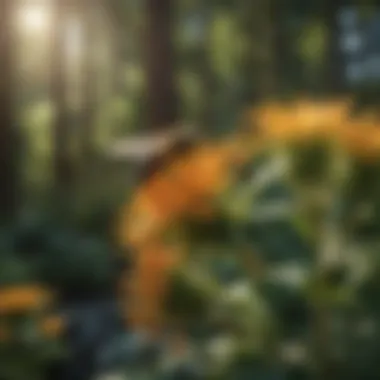
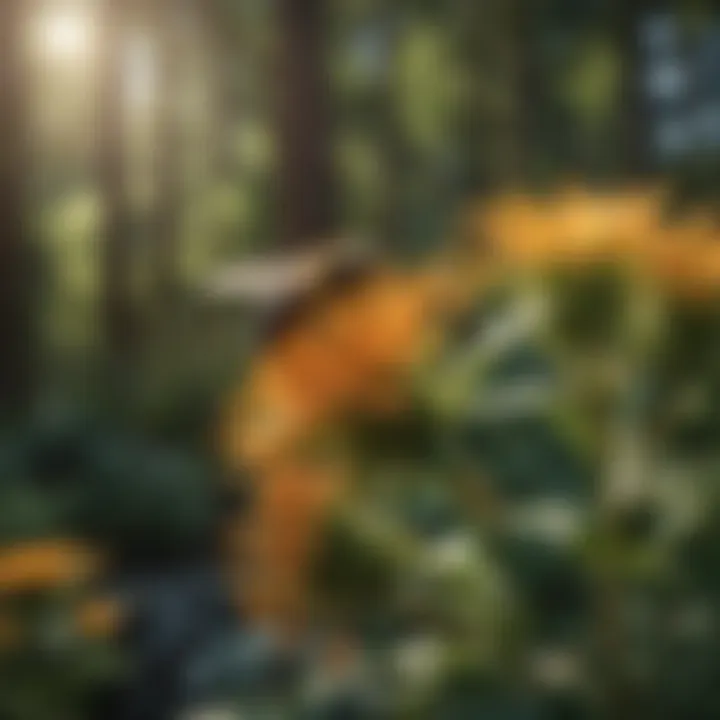
Intro
Gardens teeming with life are not just a sight to behold; they are vital for the health of our ecosystem. Bee and butterfly gardens, in particular, serve as havens for these crucial pollinators, promoting biodiversity. With concern for declining pollinator populations on the rise, creating a space dedicated to these insects has never been more paramount. Not only do such gardens play a role in sustaining local flora and fauna, they also enhance soil health and foster community engagement.
In this article, we delve into the elements that make a bee and butterfly garden thrive. By examining strategic plant selection, best management practices, and the broader implications for local ecosystems, we will outline a comprehensive guide for both individuals and organizations. This exploration will shed light on the intricate relationships that exist within these ecosystems and illustrate how each choice—big or small—affects the local environment.
Understanding Woodland Ecosystems
Importance of Biodiversity in Forests
Forests are often described as the lungs of the Earth, and for good reason. They harbor a high degree of biodiversity, providing habitats for countless species. The interdependent relationships among plants, animals, fungi, and microorganisms create a complex web that is essential for ecosystem resilience.
Incorporating diverse plant species in your garden can mimic this complexity, encouraging not only bee and butterfly populations but also other beneficial insects, birds, and wildlife.
"Biodiversity is not just about variety—it's about the interconnections within ecosystems that sustain them."
Role of Forests in Climate Regulation
The role of forests extends beyond support for biodiversity. They significantly impact climate regulation by sequestering carbon dioxide, regulating temperature, and maintaining water cycles.
By establishing a garden that supports pollinators, individuals contribute toward replicating this role on a smaller scale. A variety of plants can help stabilize local climates, moderate soil temperatures, and preserve moisture levels, all of which are critical for sustaining diverse wildlife populations.
Sustainable Gardening Practices
Principles of Sustainable Gardening
Sustainable gardening practices echo the principles of sustainable forestry. They revolve around creating habitats that thrive with little outside interference. Consider the following strategies:
- Native Plant Selection: Use plants that are indigenous to your area, as they are better adapted to local conditions and more attractive to native pollinators.
- Minimal Chemical Use: Avoid synthetic pesticides and fertilizers, which can harm beneficial insects alongside the targeted pests.
- Water Conservation: Implement rainwater collection systems and use mulch to retain moisture.
Case Studies of Successful Implementations
Take, for instance, a project initiated in Denver, Colorado. Residents transformed their backyards into vibrant bee and butterfly habitats. By primarily employing native plants—such as Rocky Mountain bee plants and butterfly weeds—they noticed not only a resurgence in pollinator activity but also an improvement in garden health overall.
The combined efforts turned a previously barren piece of land into a flourishing community space, demonstrating the power of localized, sustainable changes.
End
In cultivating a bee and butterfly garden, one doesn't merely create a personal oasis. Rather, individuals participate in an essential effort to enhance biodiversity. Understanding woodland ecosystems, along with sustainable practices, can lead to consequences that resonate well beyond local gardens. As we explore further into the intricacies of pollinator support, we empower ourselves and our communities to embrace ecological stewardship.
Understanding Pollinators: Bees and Butterflies
Understanding pollinators, specifically bees and butterflies, is pivotal when discussing garden biodiversity. These insects don't just add color and movement to our gardens; they play an irreplaceable role in maintaining ecological balance. Engaging with these pollinators leads to an appreciation of their complex lifecycle, their interactions with native plants, and their impact on food production.
Pollinators are the unsung heroes of agriculture. They kick-start the reproductive processes of many flowering plants. Without them, many crops and natural flora would struggle to reproduce, resulting in decreased food supplies and collapsing ecosystems. This interdependence means that fostering environments for bees and butterflies can amplify biodiversity, ensuring numerous species thrive in concert.
The Role of Pollinators in Ecosystems
Pollinators are the community's essential workers. They facilitate the growth and reproduction of flowering plants by transferring pollen from one flower to another. This action not only encourages plant diversity but also supports wildlife that relies on these plants as food and habitat. A garden lacking sufficient pollinators can see a decline in flowering plants, which further spirals down to affect other animals relying on plants for survival.
Bees, for instance, are responsible for pollinating one out of every three bites of food we consume. Butterflies contribute to the beauty and diversity of gardens too, but they often rely on specific host plants. This relationship supplements the food web where other animals find sustenance.
"Without pollinators like bees and butterflies, our natural world would be a sadder, less vibrant place.”
Distinguishing Characteristics of Bees and Butterflies
Bees and butterflies, while both falling under the pollinator umbrella, exhibit significant differences. Bees tend to be stout and hairy, collecting pollen on their bodies. Their color ranges from brown to yellow, which can help them camouflage amidst flowers. They are social creatures, often working in large colonies to collectively gather nectar and pollen.
In contrast, butterflies are delicate creatures with long, slender bodies and large, often brightly colored wings. They are more solitary and spend their time fluttering from one flower to another. While both are crucial for pollination, their feeding habits differ. Bees primarily collect nectar and pollen, while butterflies sip nectar through a tube-like mouth called a proboscis, often only visiting flowers with a certain shape or size.
The understanding of these distinctions is critical in cultivating environments that best support each type of pollinator. A successful bee and butterfly garden will cater to their unique needs, leading to improved biodiversity in the area.
The Importance of Biodiversity
Biodiversity is the very fabric of life; it encompasses the variety of life on Earth, from the smallest microorganisms to the largest mammals. When discussing the significance of cultivating bee and butterfly gardens, understanding biodiversity becomes central to the conversation. A diverse ecosystem is not just about having different species; it’s about the interactions between those species and how they contribute to the stability and resilience of that ecosystem.
Promoting biodiversity within gardens, particularly those designed for pollinators, brings multiple benefits. First, a diverse range of plant species supports a variety of pollinators, leading to enhanced pollination services. This, in turn, boosts the overall productivity of the garden. Each plant contributes something unique, be it shelter, food, or nesting sites, creating a harmonious habitat. In intensive agricultural systems, which often favor monoculture, such biodiversity can be scarce, revealing how crucial a simple garden can be.
Biodiversity also acts as a buffer against diseases and environmental changes. A garden thriving with diverse plants and pollinators is less susceptible to pest outbreaks compared to a homogenous planting. Just like a well-balanced diet supports a strong immune system, diverse species support each other. This interconnectedness can lead to the overall health of a garden, making it a sanctuary not just for bees and butterflies but for myriad other organisms, including beneficial insects and birds.
Furthermore, the importance of biodiversity extends beyond individual gardens. Promoting these mini-ecosystems can lead to localized initiatives that help restore and maintain ecological balance, especially in urban environments.
"Biodiversity is more than a luxury; it is a requirement for sustainable ecosystems."
Connecting Biodiversity with Pollinator Health
The health of pollinators like bees and butterflies is closely tied to the level of biodiversity in their habitat. Pollinators require a diverse food source to thrive. If a garden lacks variety, pollinators may struggle to find the nectar and pollen they need throughout different seasons. Integrating a wide selection of flowering plants can ensure they have access to resources year-round. This includes not only nectar-rich flowers but also those that serve as host plants for larvae, particularly critical for butterfly species.
In essence, gardens rich in biodiversity foster healthier pollinator populations. When gardens are designed with diverse flora, they become a buffer against environmental stressors like climate change. A resilient ecosystem, filled with various plant and animal life, will adapt much better when challenges arise.
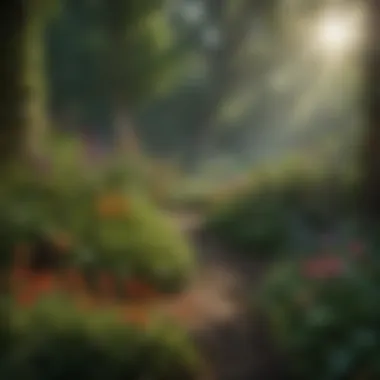

Impact of Pollinators on Food Supply
Pollinators play a vital role in the production of fruits, vegetables, and nuts. Approximately one-third of the food we consume is made possible by their efforts. When pollinators visit flowers, they not only collect food but also facilitate the transfer of pollen, resulting in the fertilization of plants. The repercussions of declining pollinator populations are dire, touching various aspects of food supply chains.
Societies that maintain pollinator-friendly environments can expect a more reliable food supply. It creates a positive feedback loop where healthy pollinator populations benefit agricultural yields, which can support local economies. Consider these points when reflecting on the impact of pollinators on our food systems:
- Increased Crop Diversity: Gardens that support bees and butterflies often lead to agricultural systems that are more diverse.
- Higher Crop Yields: Pollination greatly increases the yields of many crops, directly impacting food production levels.
- Economic Benefits: Pollinator health directly correlates with the agricultural economy. Areas with rich biodiversity see more prosperous farms and markets.
Thus, the significance of biodiversity in gardens cannot be overstated. These locations become sanctuaries for pollinators and, by extension, protect our food systems, ecological networks, and communities.
Designing a Bee and Butterfly Garden
Creating a bee and butterfly garden is more than just a hobby; it’s a commitment to enhancing biodiversity and supporting the delicate balance of ecosystems. Such gardens serve as sanctuaries for these crucial pollinators, providing food and shelter while promoting ecological health. In an age where urbanization continues to encroach on natural habitats, designing these gardens becomes critical. Not only do they offer a vibrant aesthetic, they also play a significant role in the survival of various species.
The importance of a well-thought-out design cannot be overstated. It involves more than simply plopping in a few flowers and hoping for the best. Instead, it requires a keen understanding of what appeals to different pollinators, as well as careful planning to optimize the garden's layout for accessibility and sustainability.
Assessing Spatial and Environmental Factors
Before diving into the fun part of planting, it’s crucial to assess your available space and its environmental characteristics. Each garden is unique, influenced by factors like sunlight exposure, soil quality, and moisture levels. Here are some considerations:
- Sunlight: Most pollinators prefer sunny spots where they can warm up and find energy. Note areas that receive at least six hours of sunlight daily.
- Soil Type: Different plants thrive in different types of soil. Test the soil pH and texture to determine what can flourish in your garden.
- Wind Protection: Strong winds can disrupt pollinators and damage plants. Strategically placing taller plants or barriers can protect more delicate species.
Knowing these factors aids in making informed decisions.
Key Design Elements for Attracting Pollinators
A few essential elements can turn your garden into a pollinator paradise. Let's explore these:
Native Plant Selection
Choosing native plants is one of the wisest choices for attracting local pollinators. Native flora provides the right type of food and habitat for the bees and butterflies that are naturally part of your ecosystem. These plants have evolved with local species and, therefore, are better suited to thrive in your area's climate.
Key characteristics of native plants include:
- Diversity: Local species often produce various blooms that offer nectar throughout the seasons.
- Resilience: They typically require fewer resources and maintenance, adapting well to local conditions without the need for excessive fertilizers or pesticides.
One unique feature is that many native plants, such as coneflower or milkweed, are particularly well-loved by particular butterfly species, ensuring that your garden can sustain specific life cycles. This enhances biodiversity, making your garden an intricate part of the local ecosystem.
Providing Water Sources
Water isn't just for watering the plants; it's an essential element for attracting pollinators. A small water feature or even a shallow dish can serve as a vital resource. Pollinators need water to drink, but they also use it for regulating their body temperature.
Some key characteristics to note:
- Accessibility: Make sure the water source is easy for pollinators to access. Adding stones in shallow trays can help them land safely.
- Cleanliness: It’s important to keep water sources clean to avoid stagnant conditions that can breed mosquitoes.
A unique advantage of including water sources is that they can also create an engaging and tranquil space in your garden, fostering a sense of peace and connection to nature.
Creating Shelter and Nesting Areas
Providing shelter is just as important as food and water. Pollinators need protected spaces to rest, hide from predators, and reproduce. Simple steps to create these areas include:
- Use of Mulch: Leaf litter and mulch not only suppress weeds but also provide habitat for ground-nesting bees.
- Incorporating Logs and Brush Piles: Leaving logs or brush piles in an out-of-the-way corner creates a safe retreat for many insect species.
One major benefit of this approach is the subtle encouragement of biodiversity; when specific plants and debris are present, it offers pollinators various microhabitats, each valuable to different species.
By attending closely to these design elements, your garden can become a thriving hub for bees and butterflies, offering sanctuary and sustenance in an increasingly challenging environment. This thoughtful approach not only enhances the landscape but also nurtures the intricate web of life that pollinators support.
Selecting Suitable Plants
Selecting plants that nourish and shelter pollinators is paramount when striving for a successful bee and butterfly garden. The plants you choose will determine the presence and health of these essential creatures and their food sources, directly influencing the garden's biodiversity. Carefully selecting suitable plants not only enhances visual appeal but also fosters a thriving habitat for pollinators.
Characteristics of Nectar-Rich Plants
Nectar-rich plants serve as a primary food source for bees and butterflies, enticing them to your garden. It is crucial to focus on plants that offer abundant nectar, as well as essential pollen. Here are some key characteristics to consider:
- Flower Shape and Structure: Bees often prefer flowers that are shallow and open, like daisies or black-eyed Susans. Butterflies are attracted to tubular flowers, such as honeysuckle or trumpet vine, which allow easy access to nectar.
- Color: Brightly colored flowers, especially in shades of purple, yellow, blue, and white, are more attractive to pollinators. Color influences bees' and butterflies' foraging behavior.
- Fragrance: Sweetly scented flowers can draw pollinators from afar. Planting species like lilacs or lavender can enrich the olfactory landscape of your garden.
- Native Flora: Local plants tend to be more effective at attracting native pollinators as they are adapted to local environmental conditions. Research local flora to find the best options.
Choosing a mix of these characteristics can create a vibrant garden that attracts a variety of pollinators.
Seasonal Planting for Continuous Bloom
To support pollinators throughout their active seasons, consider seasonal planting. This means including a range of plants that bloom at different times of the year.
- Early Bloomers such as crocuses and willow trees provide essential nourishment in late winter and early spring.
- Mid-season Plants like coneflowers and foxglove keep pollinators fed as the seasons advance.
- Late Bloomers such as asters and goldenrods can sustain pollinators in late summer and fall, ensuring they have a consistent food source through the changing seasons.
A well-planned timeline of blooms not only supports pollinators but also enhances the overall aesthetic appeal of your garden as various flowers come to life throughout the year.
Cultivating Host Plants for Butterflies
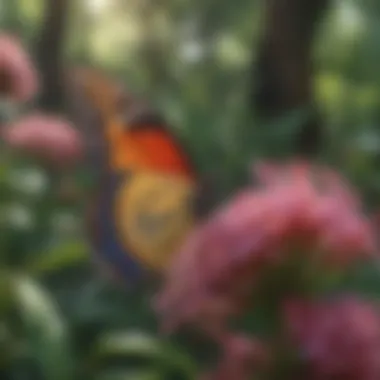
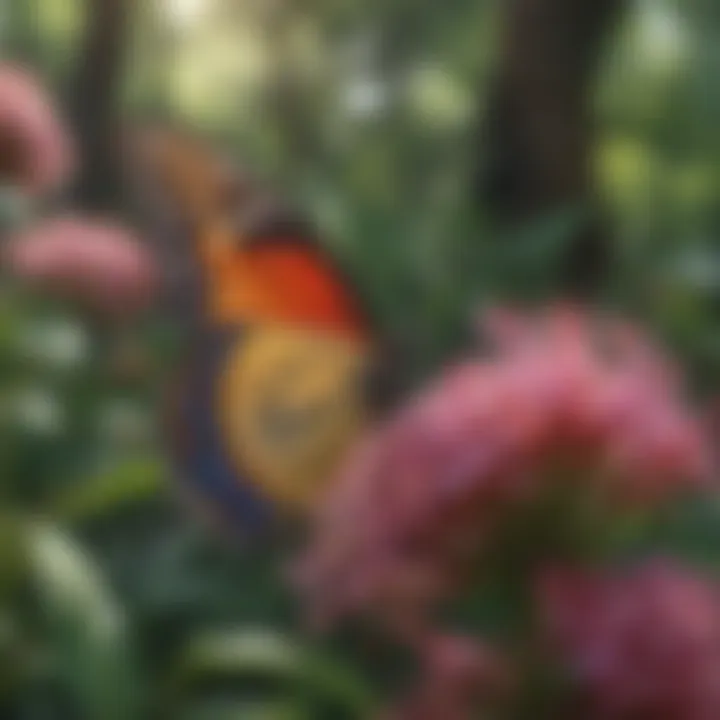
Host plants serve as the breeding ground and larval food for butterflies, making them vital for butterfly conservation. Each butterfly species has specific host plants that cater to their caterpillars.
- Identify Local Species: Take the time to discover the butterfly species native to your area and the plants they require for laying eggs. For instance, the Monarch butterfly depends on milkweed.
- Diversity is Key: Including a variety of host plants can attract different species of butterflies. For example, plant dill and parsley for Swallowtail butterflies in addition to milkweed for Monarchs.
- Natural Habitats: Host plants should mimic natural settings. If growing milkweed, it's beneficial to leave some space untended, allowing for a more organic environment where butterflies feel comfortable laying eggs.
By providing specific plants that support larval development, gardeners can greatly contribute to the butterfly population in their region.
A rich diversity of nectar-rich plants and host plants is not just a feast for pollinators but a crucial step towards fostering a sustainable environment.
In summary, selecting suitable plants entails understanding and implementing the right characteristics of nectar-rich species, ensuring continuous seasonal blooms, and cultivating essential host plants. This thoughtful selection process lays the groundwork for a vibrant, functioning ecosystem that welcomes pollinators into our gardens.
Soil and Plant Health
Maintaining robust soil health is a linchpin in cultivating a thriving bee and butterfly garden. Healthy soil not only supports plant growth but also fosters a vibrant ecosystem that encourages the presence of pollinators. The interplay between soil quality, plant vitality, and their ability to attract and sustain bees and butterflies cannot be overstated. A balanced soil structure, rich in organic matter and microbial life, directly influences the diversity of plant species one can grow. Moreover, this foundational layer holds moisture, aids nutrient absorption, and helps with disease resistance, all crucial for creating an inviting habitat for our flying friends.
Assessing Soil Quality for Pollinator Gardens
To kick-start a successful bee and butterfly garden, one must first assess the soil quality. This involves examining its texture, structure, and nutrient levels. Take a handful of soil and give it a squeeze; if it holds together yet crumbles when touched, you’ve got loamy soil—the gold standard. Use soil testing kits to check for pH levels, nitrogen, phosphorus, and potassium content. A neutral to slightly acidic pH (6.0-7.0) is optimal for most flowering plants.
Repairing poor soil conditions often starts by adding organic matter. Organic materials do wonders—they improve water retention and can even introduce beneficial microorganisms. It's like rolling out the welcome mat for a party; soil health determines who gets invited to the bash.
Organic Practices for Soil Management
Composting
Composting is in the spotlight when we discuss enriching soil naturally. It's a process that transforms kitchen scraps and garden waste into nutrient-rich organic matter. This naturally occurring process not only feeds the plants but enhances soil structure and water retention capacity. One of its key characteristics is that it recycles waste, reducing landfill contribution, which makes it an environmentally friendly choice for gardeners.
Unique Feature: Composting introduces a variety of nutrients such as nitrogen, phosphorus, and potassium, all essential for plant growth. On the downside, its effectiveness is dependent on the initial quality of the inputs. If you compost poor quality waste, the compost won’t do wonders for your soil.
Mulching
Mulching taps into a simple yet effective method of protecting the soil. It involves covering the soil with organic materials such as bark, straw, or dried leaves. This technique serves multiple purposes: it suppresses weeds, retains moisture, and prevents soil erosion. The insulating properties of mulch also create a hospitable environment for soil-dwelling creatures that support overall garden health.
Unique Feature: Mulch slowly decomposes, continuously feeding the soil over time. However, improper mulching techniques, such as using non-biodegradable materials, can negatively impact the eco-friendliness of your garden.
pH Balancing
Balancing the pH of the soil is crucial in ensuring nutrient availability to plants. Soils that are too acidic or alkaline can lock up essential nutrients, making them unavailable to plants. Testing pH can guide necessary amendments. For instance, if your soil shows high acidity, adding lime can help bring the balance back.
Unique Feature: pH balancing helps support healthy microbial populations in the soil, which are essential for breaking down organic matter and releasing nutrients. The drawback is that achieving and maintaining the right pH level can be a continuous effort, needing regular testing and amendments.
"Healthy soil lays the groundwork for a garden ecosystem where bees and butterflies can flourish, creating a magnificent tapestry of life."
Maintenance Practices
Maintaining a bee and butterfly garden is not just about keeping it pretty; it’s about building a supportive habitat that flourishes through the seasons. Appropriate maintenance practices ensure that your garden remains a beacon for pollinators while promoting overall soil health and biodiversity. Each technique works hand-in-hand to sustain an inviting environment while minimizing the workload over time. Here, let’s delve into some essential maintenance strategies.
Watering and Irrigation Strategies
Water is a lifeblood for any garden, more so for those designed to attract bees and butterflies. Proper watering techniques promote healthy plant growth, which is vital for offering adequate nectar and pollen. The best way to go about it is to assess the moisture needs of the plants regularly.
- Soil Moisture: One practical tactic is to stick your finger into the soil up to the second knuckle. If it feels dry, it's time to water. Overwatering can lead to root rot, particularly for native plants that might not need as much.
- Drip Irrigation: This is a solid choice. It delivers water directly to the roots of the plants, minimizing evaporation and runoff. It's effective and conserves water, making it a greener option.
- Timing: Watering in the early morning can also be beneficial, as it allows the plants to absorb moisture before the heat of the day leads to evaporation.
Ensuring consistent moisture levels not only helps plants thrive but also creates a conducive environment for pollinators to visit your garden.
Managing Pest Populations Naturally
Although pests can be a bane, it's essential to remember that some insects play a critical role in the ecosystem. The goal here is to strike a balance—keeping beneficial insects while managing harmful populations. Here are some natural methods to consider:
- Companion Planting: Certain plants can deter pests when grown alongside your garden’s main flora. For example, marigolds are known to repel nematodes and other common pests.
- Beneficial Insects: Introduce ladybugs or lacewings, which naturally devour aphids and other pests.
- Homemade Sprays: A mix of soap and water can be a gentle yet effective way to combat unwanted pests without resorting to harsh chemicals that could deter pollinators.
Natural control methods not only protect your plants but also contribute to a healthier garden ecosystem where pollinators can thrive without the threat of harmful chemicals.
Pruning and Propagating Plants
Pruning’s not merely about aesthetics; it plays a crucial role in maintaining plant health, encouraging flowering, and fostering new growth. Here are a few pointers for effective pruning:
- Timing: Understand the best time to prune specific plants, as this varies by species. Some do well in late winter, while others prefer summer after blooming.
- Technique: Use clean, sharp tools for cuts. Remove dead or diseased branches, as these can harbor pests or diseases. Forming an open canopy will also allow sunlight to reach the inner parts of the plant.
- Propagation: Consider propagating your plants, either through cuttings or seeds. This not only extends the life of your garden but provides a chance to introduce new varieties that attract different insects.
By investing some time into pruning and propagating, you enhance the vitality of your plants, making your garden an ongoing source of nectar and habitat for pollinators.
Proper maintenance of a bee and butterfly garden transforms it from a simple landscape into a thriving ecosystem that supports pollinators and biodiversity.
In summation, practicing diligence in maintenance makes a world of difference. Regular watering, natural pest management, and purposeful pruning ensure that your pollinator garden is not just a temporary haven but a long-standing resource for both biodiversity and community enjoyment.
Community Engagement and Education
Creating a bee and butterfly garden isn't just about planting a few flowers and waiting for the wildlife to appear. There’s a vital piece that often goes unnoticed: community engagement and education. These elements are essential, not only for maximising the ecological benefits of such gardens, but also for fostering a culture of stewardship towards our local environments. When communities take an active role, they not only contribute to biodiversity but also gain a deeper appreciation for the interconnectedness of nature.
Engaging the community serves several purposes. It cultivates awareness about the struggles that pollinators face in today’s world—like habitat loss and pesticide exposure. Furthermore, education creates informed advocates who can share valuable knowledge with others. In short, an informed community is one that’s better equipped to protect and nurture the ecosystems around them.
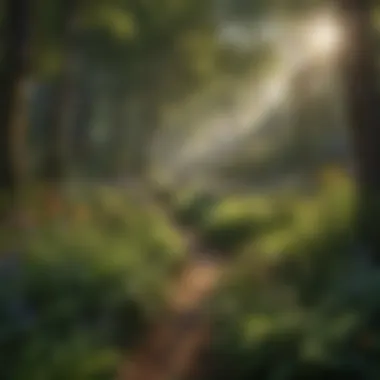

Promoting Local Initiatives and Workshops
One effective way to bring community members together is through local initiatives or workshops. These gatherings can be casual or formal but should aim to inform participants about the significance of bee and butterfly gardens.
- Workshops: Organising hands-on sessions where participants can plant flowers or build bee hotels can be impactful. Individuals learn best by doing, and when they leave with their own creations, they’re much likelier to spread the word.
- Nature Walks: Local nature walks can lead to discussions about local plants that benefit pollinators and the importance of preserving existing habitats. Facilitating such events in nearby parks or residential areas reinforces a sense of local stewardship.
- Collaborations: Partnering with schools or local environmental organizations can amplify the reach of these initiatives. Together, they can host events that draw in various age groups, allowing for intergenerational learning about biodiversity.
In addition to direct engagement, promoting these initiatives through social media channels or community boards can help reach a broader audience. Highlighting local success stories can encourage participation and ignite passion for conservation.
Creating Educational Materials for Schools
Educational institutions play a pivotal role in shaping future generations. By developing materials tailored for schools, we can instill early awareness about the importance of bees and butterflies in our ecosystems.
- Curriculum Integration: Incorporating information about pollinators into science curricula offers students a chance to learn about biology in a hands-on way. Lessons can include everything from the anatomy of a bee to the role that different plants play in their life cycles.
- Gardening Projects: Schools can set up their own gardens dedicated to bees and butterflies. Not only do these projects demonstrate the practical aspects of classroom lessons, but they also enable students to witness the direct impact of their efforts.
- Resource Kits: Providing teachers with kits that include lesson plans, craft ideas, and resources for planting can make integrating this topic into existing curricula easier. This can catalyze engagement within classrooms and foster a love for nature.
Fostering such educational outreach nurtures a generation of environmentally-conscious individuals.
The Broader Impact of Pollinator Gardens
Pollinator gardens serve as vital ecosystems that extend beyond their immediate physical space. They contribute to a much larger environmental fabric, weaving together urban landscapes, promoting biodiversity, and fostering community engagement. The design and implementation of such gardens resonate with ecological principles that not only benefit pollinators like bees and butterflies but also transform the surroundings into thriving habitats for various species. The significance of these gardens becomes apparent when we consider their broader implications on urban settings and their role in supporting local wildlife.
Enhancing Urban Environments
Urban areas are often concrete jungles, where natural habitats have been replaced by buildings and roads. Nevertheless, pollinator gardens break this monotony, injecting life back into these environments. By creating pockets of green spaces, these gardens help to mitigate the urban heat island effect, where cities tend to be warmer than their rural counterparts.
In addition to temperature moderation, they improve air quality. Plants utilized in these gardens absorb carbon dioxide and release oxygen, thereby enriching the urban atmosphere. They can also capture rainwater, reducing runoff and assisting in groundwater recharge. Every little bit helps when it comes to creating a comfortable and sustainable urban space.
Moreover, pollinator gardens have an undeniable aesthetic appeal. Streets adorned with colorful flowers attract not just pollinators but also residents and visitors. This visual beauty can transform neglected lots into vibrant community focal points, encouraging social interaction and appreciation for nature.
To truly leverage the impacts, city planners and architects should consider incorporating pollinator-friendly designs into their projects. Such practices could include:
- Utilizing native plants that are known to attract local pollinators.
- Designing communal gardens that engage residents in planting and maintaining these spaces.
- Creating educational signs that inform the public about the importance of pollinators and biodiversity.
"If we can beautify our cities while promoting ecological balance, why wouldn't we?"
– Anonymous Urban Gardener
Supporting Local Wildlife and Ecosystems
The role of pollinator gardens in supporting local wildlife cannot be understated. These gardens provide essential resources such as food, shelter, and breeding grounds for a variety of species beyond just bees and butterflies. Birds, small mammals, and countless other insects can thrive in these diverse habitats.
By cultivating a variety of plants, gardeners can establish a more complex ecosystem that mimics natural processes. For instance:
- Planting diversity: A mix of flowering plants encourages different pollinators to visit, increasing genetic diversity and resilience in surrounding ecosystems.
- Habitat creation: Nesting spots, such as logs and shrubs, foster home-seeking wildlife, contributing to their population stability.
- Food web support: By nurturing both pollinators and the plants they rely on, gardeners inadvertently bolster the wider food web, aiding predators that feast on various insect populations.
Furthermore, these gardens can serve as crucial transition zones. They facilitate safe passages for wildlife moving through urban landscapes, connecting fragmented habitats and enabling genetic exchange among isolated populations. In this sense, the pollinator garden may be small, but its reach can be extensive.
Promoting awareness of local wildlife’s needs is essential for maximizing the benefits of these gardens. Here are practical steps to encourage local wildlife:
- Avoid using pesticides to ensure a safe environment for all creatures.
- Create undisturbed areas where animals can safely bear young or find shelter.
- Collaborate with local wildlife organizations to understand best practices tailored to your region.
Evaluating Success
Evaluating the success of a bee and butterfly garden is not just a checkbox exercise. It’s about understanding whether your efforts in creating a thriving ecosystem are bearing fruit. By systematically assessing various elements, you can refine your practices, ensuring that your garden not only attracts these crucial pollinators but also contributes to their long-term survival and the overall health of your local ecosystem. A successful garden should be viewed through multiple lenses—pollinator activity, plant health, and the dynamic interplay between them.
Methods for Monitoring Pollinator Activity
To really grasp how well your pollinator garden is performing, you need to keep tabs on the visitors that flit about. Monitoring isn’t just a one-and-done task; it requires an ongoing commitment and a few strategic approaches:
- Visual Surveys: Simply standing in your garden and observing when and what types of pollinators visit can provide a wealth of information. Take note of their behavior—are they feeding, resting, or interacting with each other?
- Timed Counts: Choose specific times of the day and spend a set amount of time observing. Counts should be done consistently over time to identify patterns or shifts in pollinator activity.
- Photography: Capturing photographs of the various species can help in identification and record-keeping. This also creates a fun documentation project.
"Keeping a journal of your observations can turn into a valuable resource, allowing you to notice trends and changes over time."
- Pollinator Traps: Considering the potential to use non-invasive traps can also aid in identifying species diversity and numbers. Ensure that the traps are designed to not harm the pollinators, allowing them to be released unharmed.
The culmination of these methods gives a clearer picture of how well your garden is serving its intended purpose.
Adjusting Practices to Improve Outcomes
Once you’ve gathered data, it’s time to dig in deeper. Monitoring helps you recognize what’s working and what’s not. Here is where adjusting your practices based on your findings truly shines:
- Plant Diversity: If you notice a lack of certain species visiting your garden, it may have to do with the absence of their preferred plants. Identifying which plants are not thriving and replacing them with more desirable options can make a world of difference.
- Water Availability: Is there enough water source? Pollinators, especially butterflies, need a place to hydrate. Adding a small pond or establishing shallow dishes with rocks can enhance your garden’s attractiveness.
- Nesting Spaces: Realizing that your garden lacks suitable shelter or nesting areas for bees can spur quick action. Consider incorporating bee hotels or brush piles. Adjusting structure can dramatically enhance habitat quality.
- Seasonal Planting Schedules: Regularly assessing which plants bloom when and how it correlates with pollinator visitation can guide your planting schedule. A staggered bloom, with plants flowering at different times of the year, ensures a steady food source.
Engaging in these adjustments not only increases the likelihood of attracting more bees and butterflies but also enriches the biodiversity within your garden. Each change iteratively contributes toward a self-sustaining, resilient ecosystem, one thriving on mutual benefits where both flora and fauna flourish together.
Closure: The Future of Pollinator Gardens
Pollinator gardens hold immense potential in preserving biodiversity and fostering ecological balance. As urbanization expands and natural habitats shrink, the role of bee and butterfly gardens becomes critically important. They are not just embellishments of our surroundings; rather, they are vital sanctuaries that nurture our environment and support a plethora of species.
These gardens serve as a crucial link in the food web. The concerted efforts to establish and maintain these habitats ensure that we, too, benefit through enhanced pollination services, which directly influence crop yields and food security. Additionally, they serve as education hubs, illustrating the interconnectedness of life and ecosystems.
Long-Term Sustainability and Community Involvement
For lasting impact, the engagement of local communities is imperative. When residents are actively involved, gardens become more than just a series of plants; they evolve into community projects that promote environmental stewardship and awaken interest in nature. Here’s how community involvement can catalyze sustainability:
- Education Initiatives: Workshops on planting and maintaining bee and butterfly gardens empower individuals with knowledge on sustainable practices. Schools can be integral players in cultivating this awareness among future generations.
- Volunteer Programs: Local agencies can create opportunities for residents to volunteer in garden maintenance or educational outreach, fostering a sense of ownership and responsibility towards their environment.
- Biodiversity Monitoring: Encouraging communities to participate in monitoring pollinator activity can help gather essential data for local conservation efforts. Engaging citizens in this manner not only strengthens community spirit, but also provides valuable insights for future projects.
The symbiotic relationship formed through community engagement feeds back into the gardens themselves. As more individuals learn to care for pollinator habitats, the likelihood of creating diverse, thriving gardens increases. Local flora and fauna become adapted to these spaces as community members prioritize native plant selections and proper management practices. A collective commitment to sustain these environments can lead to fruitful partnerships with local organizations and governmental bodies, amplifying the impact beyond community boundaries.







